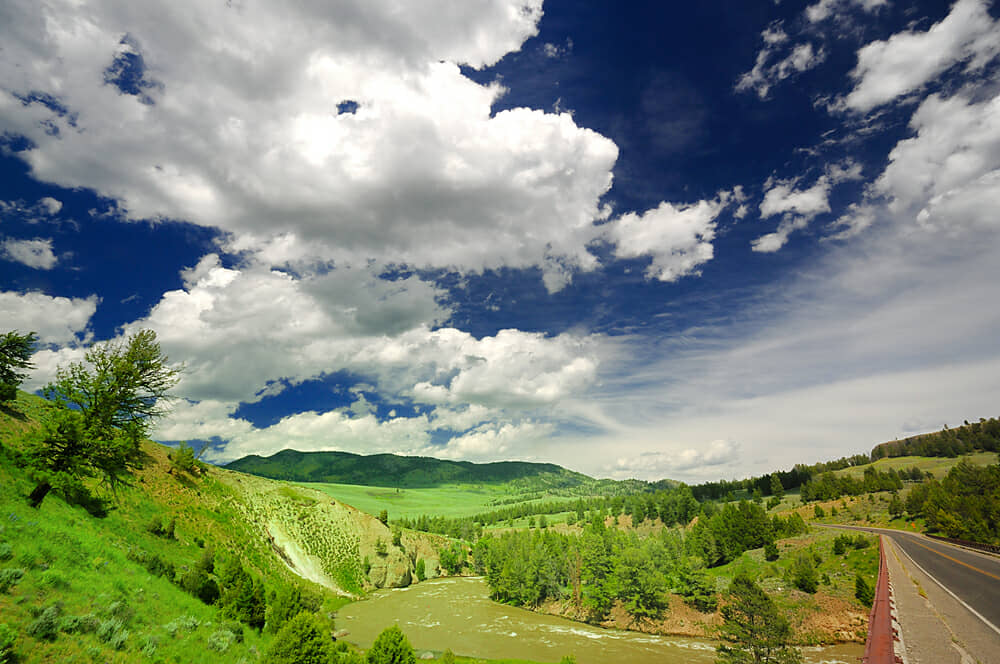The Lamar Valley is located in the northern section of the park to the east of Tower-Roosevelt. It is approximately 70,000 acres and has been called America’s Serengeti due to the amount of wildlife in the valley. The road through Lamar Valley is the only one open year-round. The Northeast Entrance is closest to the Lamar Valley.

The Valley and River are named after Lucius Quintus Cincinnatus Lamar, Grover Cleveland’s Secretary of the Interior. Geologist Arnold Hague named the east fork of the Yellowstone River for Lamar during an 1884-1885 Geolgical Survey – Lamar was Hague’s supervisor. The naming of the Lamar River, which is a 40 mile long tributary running through northwestern Wyoming, after Lamar influenced its adoption for other areas of the park, including the Lamar Valley. While serving as the Secretary of the Interior, Lamar was nominated and confirmed as an associate justice of the Supreme Court of the United States. He served on the Supreme Court until his death.
Things to Do in Lamar Valley
Lamar Valley contains much of what you would expect to be able to do in a national park. It has camping, hiking, wildlife watching, fishing and beautiful landscapes. It may not get the attention of some of the other park attractions, such as Old Faithful, but it has become extremely popular among a subset of the park visitors:
Since 1995, the area has seen significant interest due to the reintroduction of wolf packs in the valley. The last “native” wolves in Yellowstone prior to reintroduction were killed in 1926, although occasional reports of wolves in the park occurred after that date – believed to be single wolves or pairs traveling through the region.
The passage of the Endangered Species Act of 1973 called on the US Fish and Wildlife Service to develop restoration plans for species designated as endangered under the law. One of those goals was to restore the Northern Rocky Mountain wolf by promoting three recovery areas. The first wolves were reintroduced into the park from multiple packs in an area of Canada east of Jasper National Park.
Since reintroduction, thousands of visitors go to the park annually for wolf watching and they spend millions each year, with Lamar Valley the top spot to do so.
The Lamar River
The Lamar River is the largest tributary of the Yellowstone River within the park. It flows nearly 40 miles from the Absaroka Mountains through the Lamar Valley to a canyon before converging with the Yellowstone River.
America’s Serengeti
Elk, bison, grizzly bears, black bears, wolves, mule deer, pronghorn and coyotes frequent the area. Half of Yellowstone’s bison live here.
Lamar Valley Wolves
The best place to see a wolf in Yellowstone National Park is Lamar Valley. The large populations of bison, elk and other animals make it a favorite of predators such as the wolves and bears.
Lamar River Fly Fishing
The Lamar is famous for its fly fishing for native Yellowstone cutthroats. Fishing picks up following the end of spring runoff in mid-July. It is one of the last rivers in Yellowstone to see the end of snow runoff, when the dry fly fishing begins and anglers start lofting terrestrials at rising fish. The road provides easy access to much of the Lamar River in the Lamar Valley. The confluence of the Lamar River with Soda Butte Creek is a popular area for fly fishing, with areas downstream near the road also receiving attention.
Tributaries of the Lamar River include Soda Butte Creek and Slough Creek, and both are considered to have excellent fishing.
Lamar Valley Hikes
Lamar River Trail – This hike takes you through some of Yellowstone’s best wildlife watching areas. This is a 33 mile out and back that follows the Lamar River to Cold Creek. The trailhead is at the Soda Butte pullout. The parking lot for the trailhead also provides access to the Specimen Ridge Trail, Cache Creek Trail and the Miller Creek Trail.
Lamar Valley Lodging
The Pebble Creek Campground and the Slough Creek Campground are in the area. Pebble Creek has 27 first-come, first-served sites and is usually open from mid-June through September. Slough Creek has 16 first-come, first-served sites and is usually open from mid-June to mid-September.
The other option is Roosevelt Lodge Cabins in the Tower-Roosevelt area. It was built in 1920 near a campsite used by President Theodore Roosevelt. The Lodge offers rustic cabins and family-style dining. The Historic District includes 130 buildings.
The closest lodging outside of the park to the Lamar Valley is in Cooke City and Silver Gate., located in Montana just outside the Northeast Entrance. For additional options, consider Gardiner, Montana where there are more hotels and other accommodations.
Silver Gate lies just outside the Northeast Entrance – a mile past the entrance station and a few miles away from Cooke City. The year-round population is negligible – 8 according to one list I saw – but there can be a few hundred people there in the summer as they enjoy visiting Yellowstone from the town founded in 1932 and nestled between Montana’s Beartooth Mountains and Wyoming’s Absaroka Mountains.
Cooke City, which is larger than Silver Gate, has a population of around 75 people year round and around 250 people.
The economy of Cooke City and Silver Gate is based on tourism. The major areas of business are restaurants, lodging, fit shops, outfitters, gas stations and construction. They sit on the western edge of the Beartooth Highway, which provides a 68 scenic 68 mile drove between Yellowstone and Red Lodge which has been called the most beautiful highway in America.
Cooke City and Silver Gate remain accessible during the winter by way of the road through the park from Gardiner, Montana. It is the only road in the park open in the winter. The highway east of these unincorporated towns is closed from mid-October through late May.
